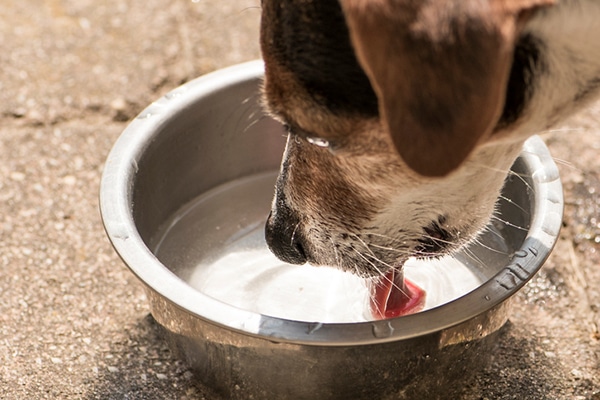Dogs may seem infallible — after all, they sometimes chew things that are never supposed to be eaten — but they can still get sick from time to time. Like people, dogs can suffer from urinary tract infections (UTIs), which can cause unpleasant symptoms like pain while urinating, frequent urination and inability to urinate. It can also lead to other urinary diseases.
Urinary tract infections have two main classifications: lower urinary tract disease (LUTD) or upper urinary tract infections. Infections that occur in the lower urinary tract involve the bladder and/or urethra, while upper urinary tract infections target the kidneys and ureters, which can sometimes be more serious. Infections in the lower urinary tract are generally more common because there is less ground the bacteria needs to cover. Once bacteria enter a dog’s urethra, its first stop is in the lower urinary tract, where it can wreak havoc. Infections spread to the upper urinary tract when they go untreated, allowing the bacteria to continue up the ureters and into the kidneys.
“Pets can get lower urinary tract disease (LUTD), which is an infection or inflammation of the bladder and/or the urethra (the tube that carries urine from the bladder to the outside of the body),” explains Dr. Russi, DVM, Banfield Pet Hospital.
Urinary tract infections happen when bacteria that naturally make themselves home in or on the body accidentally get into an area it’s not supposed to be. Bacteria like Streptococcus and Escherichia coli are common causes. Other common causes of UTIs in pets could include endocrine diseases and injuries.
“There can be several causes of LUTD, including bacterial infection, stones, anatomical defects, incontinence or even cancer,” Dr. Russi says.
Symptoms
Symptoms of UTIs in pets are a lot like the symptoms of UTIs in humans.
“If your pet has frequent or difficult urination, painful urination, inappropriate urination, blood in the urine and/or excessive licking of the genital area, he may have a LUTD,” Dr. Russi explains.
As for “inappropriate urination,” that could mean anything from inability to urinate, straining to pee, cloudy or bloody urine, sudden peeing in the house, and more. Dogs with UTIs may also vomit or exhibit signs of back pain. Like with humans, dogs with UTIs may pee more often. For example, a dog that typically sleeps through the night may get up to go to the bathroom a couple of times.

Dogster’s own Executive Editor Melissa Kauffman recently experienced UTI with both her dogs. “We had no idea,” she says. “One of our dog’s was having some health issues, so we attributed his restlessness at night and drinking more water to that. Turns out, not only did he have a UTI, but our other dog one too, and we didn’t notice any symptoms with him.” Both dogs are 10 years old, and UTIs can become more common as they get older. “Once we found out one dog had a UTI, we tested the other one — and he had it too,” she says.
“If you notice any of these symptoms or anything seems off with your pet, it’s important to contact a veterinarian who can help determine the cause of the issue,” Dr. Russi advises.
Diagnosis
When diagnosing UTIs in pets, running tests is key, just like in diagnosing UTIs in humans. With humans, a doctor would likely have you pee in a cup, then run a test. Since our dogs can’t really aim for cups, the testing process is a little different and often, more complex. Capturing a urine sample in dogs can be especially difficult because UTIs might cause a dog to not be able to pee or to urinate in small quantities. That’s where cystocentesis comes in. Cystocentesis is a procedure in which veterinarians insert a needle into the bladder through the abdominal wall in order to capture a urine sample. Once captured, a veterinarian will test the sample.
“There are several tests that can quickly assist in making a diagnosis, including a urinalysis, blood chemistry panels, X-rays or ultrasound,” Dr. Russi says. “A veterinarian will use the diagnostic tools best suited for the pet’s individual needs paired with a thorough physical exam and review of patient history to determine a diagnosis and treatment plan.”
Treatment
With most bacterial infections, the easiest available treatment often involves medications and simply encouraging your dog to pee. This could mean walking your dog more frequently and encouraging him to drink a sufficient amount of water.
According to Dr. Russi, treatment for UTIs in dogs, “can consist of antimicrobial therapy, urine pH control, medications or dietary modifications.” In order to naturally adjust the pH balance of your dog’s urine, you can add a small amount of apple cider vinegar to your dog’s water bowl, which will help manage the bacteria. Alternatively, you can try the same thing with adding fresh lemon juice in the water bowl. Remember, the more your dog drinks water, the more likely she is to flush out the infection. Some homeopathic formulas sold at pet stores could include natural ingredients such as blueberry, cranberry or echinacea.

Dr. Russi continues, “In serious cases, placement of a urinary catheter to allow for urination, intravenous fluid treatments, or possible surgical correction may be necessary.”
Prognosis
Generally, the prognosis of a urinary tract infection in pets is good. Dr. Russi advises that it’s important to stick to your pet’s treatment plan, but in most cases, UTIs or LUTDs are not something to worry about.
“While each pet is unique, if you follow the proper treatment plans given by your veterinarian, your pet should make a speedy recovery,” Dr. Russi adds. “As part of your pet’s treatment plan, your veterinarian might recommend having your pet re-checked with a follow-up urinalysis to monitor recovery.”
Of course, there are some cases in which urinary tract infections become very serious. This most often occurs when infections travel from the lower tract to higher up in the urinary system.
“In some cases, urinary tract infections can lead to serious side effects such as the development of bladder stones, prostate infections, infertility, kidney infections, and even blood infections,” Dr. Russi says.
For this reason, it is crucial to monitor your pet as much as possible and take notes of all his symptoms. If you’ve already gone to the vet for this issue, you might want to consider booking a follow-up appointment so your pet can get a follow-up urinalysis.
How to prevent UTIs in dogs
In some cases, lifestyle and dietary changes can be made in order to quash a pet’s likelihood of developing an infection.
“Your veterinarian can recommend ways you can help prevent LUTDs in your pet, depending on their unique needs and lifestyle,” Dr. Russi says.
These lifestyle changes can include adding high-sodium broth to your dog’s food, encouraging them to drink more, and adding blueberries, cranberries and echinacea into your dog’s diet. More frequent walks could also improve your dog’s likelihood of getting a UTI.

Dr. Russi adds that encouraging behaviors that naturally keep the bladder free from infection is one of the most proactive things you can do as the pet parent.
“For dogs, avoid prolonged periods of urine retention whenever possible,” Dr. Russi advises. So, in short, take your dog out to pee frequently. In order for this to work, however, you’ll have to encourage more water intake first. Some things you can do include adding high-sodium broth to your dog’s food. The sodium will make your dog thirstier, causing him to drink more. (Only do this if your veterinarian recommends it as it may exacerbate other health issues your dog may have.) You can also find specially formulated foods for dogs with UTIs at your local pet store or prescription diets through your veterinarian.
“While female dogs typically empty their bladders completely when they urinate, male dogs often only urinate small amounts at a time, keeping a reservoir available for marking territory,” Dr. Russi continues. “It may help with male dogs to take them for a long walk before going to work or bed, allowing them to completely empty their bladders. As with people, repeatedly being forced to wait to urinate can promote UTI development!”
Staying properly hydrated can also help deter the development of UTIs in pets.
“It’s also important to make sure your pet always has access to clean water to stay hydrated,” Dr. Russi adds. “The act of urination can physically remove bacteria that is trying to make its way up the urethra. Appropriate hydration can help reduce the chance of stone formation which can complicate or contribute to a urinary tract infection.”
Understanding if your dog is more prone to UTIs can be crucial to preventing them. Urinary tract infections are more common in dogs ages 7 and up and also, females. Male dogs have a longer urethra, which makes it more difficult for bacteria to get into. Some breeds are also more susceptible than others, as their bodies are more likely to develop kidney stones. These breeds include Bichon Frise, Shih Tzu and Yorkshire Terriers, thanks to their anatomy; since each of these breeds are generally shorter, they’re closer to the ground, meaning their urethra might be more frequently exposed to feces left on the ground.
Learn more about UTIs and other common health problems in dogs at dogster.com:
- The Top 6 Urinary Diseases in Dogs
- How Common is Lyme Disease in Dogs?
- What Is Periodontal Disease in Dogs?
About the author: Stephanie Osmanski is a freelance writer and social media consultant who specializes in health and wellness content. Her words have appeared in Seventeen, Whole Dog Journal, Parents Magazine and more. She is currently pursuing an MFA in Creative Writing at Stony Brook Southampton and writing a memoir. She lives in New York with her Pomsky, Koda, who is an emotional support animal training to be a certified therapy dog.
Featured Image Credit: dosecreative | Thinkstock.









